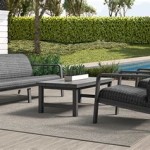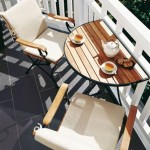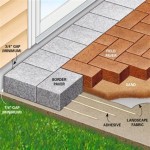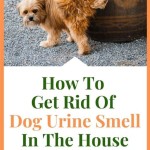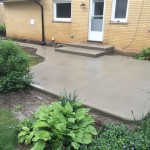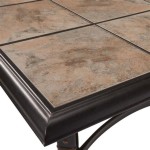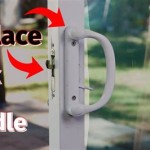How To Clean Fabric Patio Furniture
Fabric patio furniture provides comfort and style to outdoor living spaces. However, exposure to the elements inevitably leads to dirt, stains, and mildew accumulation. Regular cleaning is essential to maintain the appearance and longevity of these furnishings. Proactive maintenance can prevent permanent damage and ensure your outdoor furniture remains inviting and comfortable for years to come. This article provides a comprehensive guide on how to effectively clean fabric patio furniture, covering various cleaning methods and preventative measures.
Understanding Fabric Types and Cleaning Codes
Before beginning any cleaning process, it is crucial to identify the type of fabric covering your patio furniture. Different fabrics require different cleaning approaches. Understanding the manufacturer's cleaning code is paramount to avoid damaging the material. This code, typically found on a tag attached to the furniture, offers specific instructions for cleaning.
Common cleaning codes include:
*W:
Indicates the fabric can be cleaned with water-based cleaners. *S:
Indicates the fabric requires solvent-based cleaners (dry cleaning only). Water-based cleaners may cause staining or shrinkage. *WS:
Indicates the fabric can be cleaned with either water-based or solvent-based cleaners. *X:
Indicates professional cleaning only. Vacuuming or light brushing is recommended for maintenance. Avoid using water or solvents.If the cleaning code is unavailable, it is advisable to test the cleaning solution on an inconspicuous area of the fabric before applying it to the entire surface. This will help identify any potential discoloration or damage.
Common fabric types used in patio furniture include:
*Acrylic:
Acrylic fabrics are known for their durability, water resistance, and fade resistance. They are relatively easy to clean and are typically coded W or WS. *Polyester:
Polyester is another durable and stain-resistant fabric option. It is often treated with water-repellent coatings. Similar to acrylic, polyester fabrics are usually coded W or WS. *Olefin:
Olefin fabrics are highly resistant to mildew, stains, and fading. They are often used in outdoor furniture applications due to their weather resistance. Olefin fabrics typically have a code of W or WS. *Solution-Dyed Acrylic:
This type of acrylic has color infused into the fiber itself, making it exceptionally fade-resistant and durable. It is a premium option and generally coded as W or WS. *Vinyl:
Vinyl is a waterproof and easily cleanable material. While not a fabric, it is commonly used for patio furniture cushions and is easily wiped down with soap and water.Essential Cleaning Supplies and Tools
Having the right cleaning supplies and tools can significantly improve the efficiency and effectiveness of the cleaning process. Here is a list of essential items:
*Vacuum Cleaner with Brush Attachment:
Used to remove loose dirt, dust, and debris before wet cleaning. *Soft-Bristled Brush:
Ideal for scrubbing fabric without causing damage. Avoid using stiff brushes that can fray or tear the material. *Spray Bottle:
Used to apply cleaning solutions evenly onto the fabric. *Buckets:
For mixing cleaning solutions and rinsing. *Clean Cloths or Sponges:
For wiping and scrubbing the fabric. Microfiber cloths are particularly effective at lifting dirt. *Garden Hose with Spray Nozzle:
For rinsing the furniture after cleaning. *Mild Dish Soap:
A gentle and effective cleaning agent for many fabrics. *White Vinegar:
An excellent natural cleaning solution for removing mildew and stains. *Baking Soda:
Can be used to deodorize fabric and absorb stains. *Enzyme Cleaner:
Specifically designed to break down organic stains like food spills and pet accidents. *Fabric Protector Spray:
Applied after cleaning to help repel water and stains. *Rubber Gloves:
To protect hands from cleaning solutions.Always test any cleaning solution in an inconspicuous area before applying it to the entire piece of furniture. This will help prevent damage or discoloration.
Step-by-Step Cleaning Methods for Fabric Patio Furniture
The following sections detail various cleaning methods based on the type of cleaning required, ranging from general cleaning to stain and mildew removal.
General Cleaning
Regular cleaning is essential to prevent dirt and grime from accumulating and becoming difficult to remove. This method is suitable for fabrics coded W, WS, and some vinyl materials.
- Preparation: Remove any loose cushions or pillows from the furniture frame. Vacuum the fabric thoroughly using a brush attachment to remove loose dirt, dust, and debris. Pay attention to seams and crevices where dirt tends to accumulate.
- Mixing the Cleaning Solution: In a bucket, mix a small amount of mild dish soap with warm water. Avoid using excessive soap, as it can be difficult to rinse completely.
- Applying the Cleaning Solution: Dip a clean cloth or sponge into the soapy water and wring out the excess. Gently wipe down the fabric, working in sections. Avoid soaking the fabric.
- Scrubbing (If Necessary): For stubborn dirt or stains, use a soft-bristled brush to gently scrub the fabric. Work in circular motions to loosen the dirt.
- Rinsing: After cleaning, rinse the fabric thoroughly with clean water using a garden hose with a spray nozzle. Ensure all traces of soap are removed. Excessive soap residue can attract dirt and promote mildew growth.
- Drying: Allow the fabric to air dry completely. Position the furniture in a sunny location to accelerate the drying process. To prevent water spots, blot the fabric with a clean, dry towel.
Stain Removal
Specific stain removal techniques are required for different types of stains. Addressing stains promptly is crucial to prevent them from setting in and becoming permanent.
Food and Drink Stains:
For fresh food and drink stains, blot the stain immediately with a clean cloth to absorb as much liquid as possible. Avoid rubbing the stain, as this can spread it further. Mix a small amount of mild dish soap with water and apply it to the stain. Gently blot the area with a clean cloth until the stain is lifted. Rinse thoroughly with clean water and allow to air dry.
Oil and Grease Stains:
For oil and grease stains, sprinkle baking soda on the affected area to absorb the oil. Allow the baking soda to sit for at least 30 minutes, or preferably overnight. Vacuum up the baking soda. Mix a small amount of dish soap with water and apply it to the stain. Gently scrub the area with a soft-bristled brush. Rinse thoroughly with clean water and allow to air dry.
Pet Stains:
For pet stains, use an enzyme cleaner specifically designed to break down organic matter. Follow the manufacturer's instructions for application. In general, enzyme cleaners should be sprayed onto the stain and allowed to sit for a specified period before being blotted up with a clean cloth. Rinse thoroughly with clean water and allow to air dry.
Ink Stains:
For ink stains, blot the stain with a clean cloth dampened with rubbing alcohol. Work from the outside of the stain towards the center to prevent it from spreading. Repeat until the ink is lifted. Rinse thoroughly with clean water and allow to air dry. Always test the rubbing alcohol in an inconspicuous area first to ensure it does not damage the fabric.
Mildew Removal
Mildew is a common problem on outdoor furniture, especially in humid environments. Mildew appears as black or gray spots on the fabric.
- Preparation: Move the furniture to a well-ventilated area, preferably outdoors. Wear a mask and gloves to protect yourself from mold spores.
- Mixing the Cleaning Solution: In a bucket, mix one part white vinegar with one part water. Vinegar is a natural antifungal agent that effectively kills mildew.
- Applying the Cleaning Solution: Spray the vinegar solution onto the affected areas of the fabric. Allow it to sit for at least 15 minutes to penetrate the mildew.
- Scrubbing: Use a soft-bristled brush to scrub the mildewed areas. Work in circular motions to loosen the mildew.
- Rinsing: Rinse the fabric thoroughly with clean water using a garden hose with a spray nozzle. Ensure all traces of vinegar are removed.
- Drying: Allow the fabric to air dry completely in a sunny location. Sunlight helps to kill any remaining mold spores.
- Severe Mildew: For severe mildew infestations, a solution of diluted bleach (one part bleach to ten parts water) can be used. However, use this solution with caution, as it can damage or discolor some fabrics. Always test the bleach solution in an inconspicuous area first. Apply the bleach solution to the affected areas, scrub gently, rinse thoroughly, and allow to air dry.
Preventative Measures to Prolong Fabric Life
Taking preventative measures can significantly extend the life of your fabric patio furniture and reduce the frequency of cleaning. Here are some key strategies:
*Cover Furniture When Not in Use:
Use waterproof patio furniture covers to protect your furniture from the elements when not in use. This will shield it from rain, sun, and dirt. *Store Cushions Indoors:
During periods of heavy rain or prolonged absence, store cushions indoors in a dry place. *Regular Vacuuming:
Vacuum your patio furniture regularly to remove loose dirt and debris. This will prevent dirt from becoming embedded in the fabric. *Apply Fabric Protector:
Apply a fabric protector spray after cleaning to help repel water and stains. Reapply the protector every few months, or as directed by the manufacturer. *Promptly Clean Spills:
Address spills and stains immediately to prevent them from setting in. *Proper Ventilation:
Ensure adequate ventilation around your patio furniture to prevent mildew growth. *Avoid Placing Furniture Under Trees:
Avoid placing furniture directly under trees, as falling leaves and debris can stain the fabric. *Regular Inspection:
Regularly inspect your patio furniture for signs of wear and tear, mildew, or damage. Address any issues promptly to prevent them from worsening.
How To Clean Patio Furniture Mesh Complete Guide

To Clean Outdoor Patio Furniture Cushions Treat Them Like A Rug Wirecutter

How To Clean Patio Furniture And Scentsible

How To Clean Sling Furniture Youtube

How Can I Clean Mesh Patio Dining Chairs Hometalk

How To Clean Outdoor Cushions In 34 Seconds Highwood Usa

How To Clean Outdoor Cushions And Scentsible

How To Easily Clean Outdoor Cushions So They Last For Years Smallish Home

How To Clean Outdoor Furniture Fabric Mold Mildew Dirt Phifer

How To Easily Clean Outdoor Cushions So They Last For Years Smallish Home

